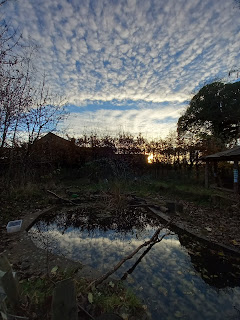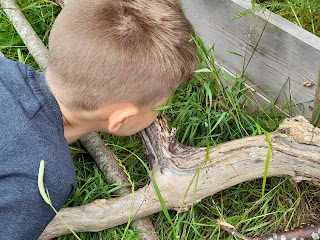Forest School Set Up
As every school varies, so does every Forest School.
There is a lot to influence how it is implemented:
- Location of site
- What makes up the site
- The age of the children participating
- The number of children participating
- Adult:Child ratios
- How long sessions last
- How frequent are sessions for each group
And that is before you bring the Forest School Leader's interpretation of the ethos and own particular strengths into play!
What I would've said to each of these points 2 years ago is not what I would say today, because covid has altered the way we implement Forest School at Chartham, throwing more variations into the mix.
For us, our Forest School site is on school grounds. This means we did not have to source a space. We do not have to rent land or use an outside agency to provide sessions. We do not need a travel policy and staff who would normally be with each group INSIDE the building can accompany them to FS and support them outside too.
Some schools with the space to provide sessions may buy in the services of an FSL rather than having one on staff.
I am the only Forest School trained member of staff. Some schools have more than one FSL. Some have a mix of level 1, level 2, and level 3 qualified staff. Some have staff who have two roles, ie class teacher released two afternoons a week to provide Forest School. I am a dedicated FSL with no other role within school.
Many Forest Schools are independent and run their own sites. Some offer full-day sessions, some do a morning and afternoon split. This may be a service schools buy into, but it may also be something extra curricula that parents sign up for. It can be a form of child care, it can include parental involvement, it can be an entire week block for a holiday club.
Forest School is frequently linked to EYFS. Partly because Early Years are committed to all kinds of outdoor learning, and partly because they have the most flexible curriculum and timetables for freeing up time to take a class outside.
Many Day Nurseries include FS in their weekly, if not daily, provision.
Despite all these variables, the ethos should remain the same: sessions are child-led, and each individual is free to follow whatever exploration they choose.
All Forest School sessions should start and end at basecamp, rules should be reiterated, discussion on how the children wish to progress should be noted, participants should be appropriately dressed, and curiosity & investigation is encouraged.
Then the personality and strengths of the Forest School Leader will come into play. Some love to teach 'survival skills' like shelter building and starting campfires, some introduce a lot of arts and crafts and create things outside, some sing at every session, some cook at every session, some arrive in the woods almost empty-handed, others have to pack a car full of equipment!
None of this is right or wrong.
What experiences are required for a group of the same children outdoors, all day, every day, for a week, may not be the same as the activities for a small group who head outside for one afternoon every two weeks!
Currently, every class (14) has at least one session a week for up to 90 minutes.
Which is a change we had to adapt to!
I have worked in two Forest Schools but have visited many more. Both jobs were in woodland on-site in a school but were different in set-up. The ability to keep equipment at hand makes it much easier to follow the children's learning.
I always have laminated information sheets, guide books, and magnifiers at basecamp. They are separated into three sections: birds, bugs, and trees/plants.
Children can come and collect whatever they want to go and explore or to come and ID what they have seen.
The popularity of a digging area never ceases to amaze me! We are lucky enough to have the space to use full-size garden spades and forks to make channels and tunnels and holes. This activity was just as popular with garden trowels and hand forks in a smaller area.
Climbing trees and into the more mature bushes is something I can't specifically supply as an FSL, but we're lucky enough to have some mature woodland so it is always enthusiastically embraced!
Then there is woodcraft. We have a tool area but I frequently use basecamp as the centre of activities. We an array of tools that I have used with small groups, but as we currently have entire classes out at once it's difficult to introduce them when there is no possibility of every child in the session having the opportunity to join in. For large groups, I stick to peelers and palm drills as they can be used fairly independently. When I can ensure the children can be instructed how to use other tools safely, with 1:1 time with me, and work in a small group of 1:3 while using, AND I won't be called away needed elsewhere, this will expand.
We have also introduced a form of noughts-and-crosses, a log with nails in to weave around, and weather/season info sheets, art-in-situ, weaving, tag games, den building, planting, and assorted other activities over the year. Mostly I respond to questions, ideas, and information the children bring to me, and from there we extend into discussion and activities.
In a perfect world we would be able to have both!
Overclothes can be added to school uniform lists, and/or parents can be requested to supply them, but this doesn't mean the children will arrive suitable dressed.
When looking for a Forest School for your child to join in with you will need to have a good idea of what you want from it and have a chat with those in charge about what they offer.
If your child is joining in sessions at school there should be information freely available regarding what it will entail.
Post covid a lot more schools are looking to introduce Forest School if they can. Setting up a site is going to be dependent on so much! The Nursery Class I used to take outside for 6 x weekly sessions, three times a year, never needed activities. They just wanted to explore and clamber over logs, look for bugs, climb through bushes, find tunnels, scale the smaller trees, dig, touch EVERYTHING, listen, smell, look... immersion in an environment they were unused to was both sensory overload and freedom!
Once they moved into year R we could introduce bug boxes and magnifiers, and sheeting for making dens as a team. We would have peelers for taking the bark off sticks and make crowns and story sticks. Again these children had 6 x sessions in Autumn Term, Spring Term and Summer Term.
My current timetable means we can progress through outdoor skills at a greater pace!
We evolve all the time. Adapting to the year group, the season, the equipment, the weather, the space, the site, and even a pandemic!
Every Forest School is different.
Finding what works for you will be trial and error.
NB
The Forest School Association has a booklet on 'How to set up a Forest School' click HERE for link














Comments
Post a Comment